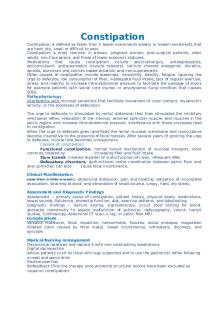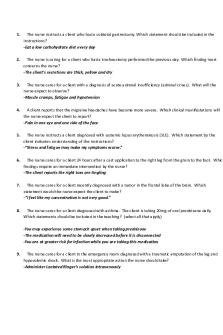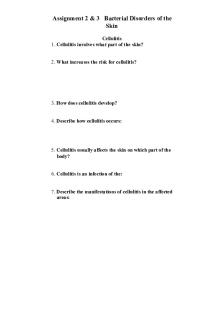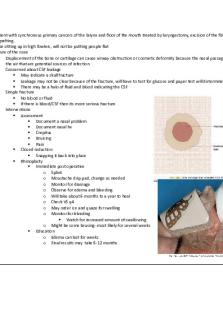Med Surg 2 Exam Practice Questions 2019-2020 PDF

| Title | Med Surg 2 Exam Practice Questions 2019-2020 |
|---|---|
| Course | Primary Concepts Of Adult Nursing |
| Institution | Nova Southeastern University |
| Pages | 18 |
| File Size | 500.6 KB |
| File Type | |
| Total Downloads | 8 |
| Total Views | 138 |
Summary
Med Surg 2 Exam Practice Questions 2019-2020...
Description
Exam 1 1. Delegate which patient? - Patient who is having a portable x-ray done 2. Orthopedic nurse is floating on the unit. Which patient should be given to her? - Patient with an infected surgery site 3. Homecare nurse is planning visit for the day and plans of visiting the first client at 0800. List in order of priority the nurses best plan based on need for visit. Note that all the clients live within 5 miles of each other. (3,4,2,1) - Client require teaching fasting blood glucose testing before self administration of morning insulin (3) - Client recently diagnosed with CHF being cared by home health aide for the first time who is scheduled to arrive at the home at 0900 (4) - Client with HTN and diabetes who requires daily dressing change (1) - Patient with angina and colon cancer that is discharged from the hospital, spouse lives with the client. The client will need assessment. (1) Synergy Model Synergy model: orient family 4. The core concept of the model understands nursing characteristics on competencies are influenced by: SATA - Restore the patient to an optimal level of wellness 5. When assessing a client who is highly susceptible to actual or potential stressors that may adversely affect patient outcomes, the nurse is evaluating: - Vulnerability 6. The assessing the extent to which the client can expect a certain course of events the nurse is evaluating: - Predictability 7. When assessing the resource availability of the client family following factors in the assessment: SATA - Personal support - Social support - Psychological support 8. A nurse is caring for a client according to the AACN Synergy Model for a patient care guideline. When assessing the client’s capacity to improve after a stressor, the nurse is evaluating: - Resiliency 9. Which of the following statements is the core concept of the synergy model of practice? - Meet the needs of client, family, influence nursing competencies 10. What makes up the synergy model? - Patient, family, nurse
11. Which one of the following statement about visitation in the critical care unit is true: - Individualized visitation based on client and family needs 12. Patient is disoriented after 3 days on CVICU, what do you do? - Encourage family to reorient patient in CCU to decrease confusion 13. Anxious family members, what do you do? - Give periodically updates 14. A patient in ICU? - Will have sensory overload 15. The nurse staff recognizes two priorities needs that family member of a critical ill client are: - Have flexible time to visit the client and have personal comfort needs met 16. During the hospitalization of a client with a myocardial infarction, the nurse should plan to start client and family teaching about the disorder - While the client is in the cardiac care unit (CCU) Meds 17. Question states INR 2.6 / PT? - Give medications as ordered 18. What breaks clots? - T-Pase 19. Tropol XL (Metropolo) in NG Tube (extended release)? - Call health care provider 20. Patient comes in with severe chest pain and complaining and saying" I feel like an elephant is Sitting on my chest" to relieve the pain the nurse would give: - Morphine CHF 21. What are other signs that suggest a patient has CHF - An S3 heart sound 21. New orders are obtained for a client who has a diagnosis of acute exacerbation of congestive HF and is admitted to the medical-surgical/telemetry floor. Which of the following drugs should the nurse anticipate will be ordered? SATA - Captopril (Capoten) ACE Inhibitor - Atenolol (Tenormin) beta-blocker - Lasix (Furosemide) Diuretic 22. Patient is home with worsening heart failure. What statement would indicate to the nurse that an intervention is needed? - “I have been waking up in the middle of the night at 2:00 am feeling SOB
23. Pt. teaching CHF outcome? - Pt. will monitor daily weight 24. A patient in heart failure has an order for atenolol and furosemide; the pulse is 56/min, respiratory rate is 17/min, and blood pressure 126/76. The nurse should? - Hold atenolol and give furosemide 25. Bibasilar crackles in lungs, vitals are normal… - Give both medications 26. Patient with a history of DVT, what do you do? - IVC (intravenous cath) 27. When assessing a client who is diagnosed with left ventricular heart failure, the nurse interprets which of the following statements correlates with the diagnosis. - “I cannot climb the stairs in my house without becoming SOB.” 28. A nurse should determine that teaching regarding a 2 gram sodium diet for a client who has a history of cardiac disease, is effective if the client states, - “I can eat most foods as long as I do not add salt when cooking or at the table.” 29. When taking a history from a client, which of these questions should the nurse ask when assessing a client for paroxysmal nocturnal dyspnea? - “Are you waking up SOB?” 30. The nurse is assessing an older client admitted with SOB, 3+ bilateral pitting edema, and crackles at bases on auscultation. Which of the following should the nurse assess first? - Blood pressure 31. Which of the following statements is an indication that a client needs additional teaching regarding a treatment regimen for heart failure? - “I should only weigh myself once a month and watch for fluid retention.” 32. A nurse is assessing a client with left sided heart failure and finds bilateral 2+pitting edema of the ankles. Which of the following signs or symptoms should the nurse also anticipate finding? - Jugular venous distention 33. A charge nurse in a long-term care facility that has RN, LPN/LVN and nursing assistant staff members has developed a plan for ongoing assessment of all residents with a diagnosis of heart failure. Which of these activities included in the plan is most appropriate to delegate to the nursing assistant staff? - Weigh all residents with HF each morning 34. A nurse is caring for a client with an admitting diagnosis of HF. The medical record contains a notation that the client is orthopneic. The most appropriate nursing intervention to assist with this client’s problem would be to - Provide several additional pillows for sleeping 35. A nurse is monitoring a client with congestive heart failure. Which of the following would require further evaluation by the nurse?
-
Weight gain of 1.5 pounds in 24 hours
36. A client who experiences an MI develops left ventricular heart failure. For which sign of poor organ perfusion should the nurse monitor this client? - Urine output of 50 mL in two hours 37. A nurse is caring for a client with congestive heart failure. A priority assessment at this time would be to - Obtain daily weights. 38. When the client with left sided heart failure develops bilateral 2+ pitting edema of the ankles, the nurse should assess that this could be early manifestation of: - Right sided failure (Left-sided HF leads to right sided HF) 39. A nurse is developing a teaching plan for a client with congestive heart failure, which of the following outcomes indicates to the nurse that the treatment is effective? SATA - Clients weight today is 79.5 kg and yesterday’s weight was 80.2 kg - Urinary output of 480cc over the previous 24 hours??? - Auscultated clear lung sounds bilaterally - Able to walk to the bathroom without dyspnea 40. During the initial home visit, the nurse is teaching a client with heart failure how to prevent complications and future hospitalizations. Which of the following statements if made by the client indicates the client’s understanding? I will call my health care provider if: - I become increasingly SOB at rest - I gain 2 pounds in one day - I have to sleep sitting up in a reclining chair Pulmonary Edema 41. Patient with heart failure has bilateral crackles and pulmonary edema. The UAP can put the patient in a: SATA - Upright position in bed - Sit the patient in bed with legs dangling over side of bed 42. An elderly client with a history of heart failure is admitted to the coronary care unit with acute pulmonary edema. He is intubated and placed on a ventilator. Which of the following parameters should the nurse closely monitor when assessing the clients response to a bolus of IV furosemide (Lasix)? - Hourly urine output 43. What treatment does the nurse anticipate to be ordered for a patient with pulmonary edema? - O2 and Lasix 44. Patient has PE? - Stasis of blood Dysrhythmias 45. Lidocaine IV is for?
- PVC’s 46. Pain and PVC’s - Decreased cardiac output 47. A critical ill client with cancer shows asystole in the monitor, he does not have a DNR on the chart, what should the nurse do? - Initiate a CPR and call a code 48. A nurse is caring for a client who has a dysrhythmia. The client suddenly develops a drop in blood pressure, chest pain, and decreased mentation. The nurse should understand that this dysrhythmia is related to which of the following conditions? - Decreased Cardiac Output 49. RN caring for client on cardiac monitor whose rhythm suddenly changes. There are no P waves. Instead the nurse observes wavy (squiggly) lines, QRS normal configuration and occurs regular, HR 140 (120). The nurse determines this rhythm as? - Atrial fibrillation 50. The client’s telemetry cardiac monitor shows a rhythm of sinus tachycardia with frequent PVCs. Which drug should the nurse administer first? - Amiodarone 51. The nurse assesses the complex marked as “A” on the following 6 second strip as a
-
PVC (premature ventricular contraction).
52. A client who has A-Fib is ambulating in the hallway on the coronary step down unit and suddenly tells the nurse, “I feel really dizzy.” After assisting the client to sit down, which of the following interventions should become a priority for the nurse? SATA - Check the client’s apical heart rate - Take the client’s blood pressure 53. In evaluating a client’s ECG tracing, the nurse notes three small squares between the upstroke and downstroke of the QRS complex. The nurse should record the QRS complex as - 0.12 seconds
54. A nurse assessing an ECG rhythm strip. The P waves and QRS complexes are regular. The PR interval is 0.16 seconds and QRS complexes measure 0.06 second. The overall heart rate 64 BPM. The nurse assesses the cardiac rhythm as - Normal Sinus Rhythm 55. After measuring 3.5 small boxes between the onset of the Q wave and the completion of the S wave, the nurse would record the QRS duration as - 0.14 second 56. In evaluating a client’s telemetry reading, the nurse should understand that:
-
“A” represents atrial depolarization, “B” represents ventricular depolarization, “C” represents ventricular repolarization.
57. A nurse is caring for a newly admitted client on the telemetry unit and notes the following on the monitor. The nurse correctly documents this rhythm as
-
Sinus tachycardia
58. A client develops the following cardiac dysrhythmia. The nurse anticipates the following management? SATA - Adenosine - IV Cardizem
-
Carotid Massage
59. An elderly patient admitted to the emergency department with an overdose of metoprolol becomes dizzy and hypertensive. The nurse notes the following dysrhythmia. Which of the following measures should receive priority? - Atropine
60. A patient admitted with an acute myocardial infarction develops chest pain, pulmonary edema, significant hypotension, and a sudden onset of the following dysrhythmia. Which of these measures if included in the care plan for this patient would be most effective in reducing clinical manifestations? SATA - IV Cardizem - Metropolol (Lopressor) - Electrical Cardioversion
61. The nurse is watching the cardiac monitor and notices the rhythm suddenly changes. There are no P waves, the QRS complexes are wide, and the ventricular rate is regular but more than 140 beats/min. The nurse determines that the client is experiencing which dysrhythmia? - Ventricular Tachycardia 62. The nurse notes that a client with sinus rhythm has a premature ventricular contraction that falls on the T wave of the preceding beat. The client’s rhythm suddenly changes to one with no P waves, no definable QRS complexes, and coarse wavy lines of varying amplitude. How should the nurse correctly interpret this rhythm?
-
Ventricular Fibrillation
63. The nurse is caring for a client who converts from NSR to AFIB. BP 150/76 RR 20, normal chest expansion and clear lungs bilateral. IV Heparin and Diltiazem (Cardizem) are infusing. The nurse understands the goal of Cardizem is to? - Control ventricular rate 64. A nurse is caring for a client who converts from normal sinus rhythm at 72/min to atrial fibrillation with a ventricular response at 164/min. Blood pressure is 160/76. Respiratory rate is 20/min with normal chest expansion and clear lungs bilaterally. IV heparin and diltiazem (Cardizem) sit to - Control ventricular rate 65. A nurse is caring a client whose ECG monitor clearly shows one impulse stimulating the ventricles, and one impulse stimulating the atria. Irregular PR intervals, and more P waves than QRS complexes. The nurse understand that management may include the following: SATA - Temporary Pacemaker - Permanent Pacemaker - Maintain Cardiac Output 66. The nurse enters Med Surgical room to find the client on cardiac arrest. CPR has been initiated and code team is alert. Upon arrival of the code team and placement of client on cardiac monitor, it is determined that the ECG shows VTACH. What is the priority action of the client? - Defibrillate Pacemaker 67. Patient with less that 60 bpm - Get a pacemaker installed 68. A client in sinus bradycardia, with a heart rate of 45 beats/min, complains of dizziness and has a blood pressure of 82/60 mm Hg. Which prescription should the nurse anticipate will be described? - Prepare for transcutaneous pacing 69. The health care team is discussing the following four clients at the interdisciplinary care conference. Which of the following clients might be a potential; candidate for a pacemaker? - The 45 year old client with an Acute MI, HR 46, BP 80/50 ACS 70. Teaching effective know importance of daily weight 71. 64 YO diabetic with history of stable angina and has sublingual nitro ordered 72. Stable angina is relieved by rest 73. CK-MB, Troponin = SATA Select Myoglobin if its an option.
74. A nurse is working in the emergency department (ED) when a client arrives complaining of substernal and left arm discomfort that has been going on for about 3 hours. All of these baseline lab tests are drawn. Which of these lab values will be most useful in determining whether the nurse should anticipate implementing the acute coronary syndrome standards orders? - Troponin 75. Heparin and warfarin can be given at the same time. 76. Chart 1245 went to 27 RR, 90% O2 - High fowler position 77. A nurse notes in a client’s diagnostic testing report that the morning labs are: Na 135 mEq/L, K 2.9 mEq/L, Cl 100 mEq/L, glucose 92 mEq/L, and BUN 14 mEq/L. The medications due at 0900 include digoxin (lanoxin) 0.25 mg PO daily and atenolol (Tenormin) 25 mg PO BID. The vital signs are T 37.2 HR 64, RR 16, and BP 122/70 mmhg. Which is the most appropriate action for the nurse to take at this time? - Give atenolol hold digoxin 78. The patient is complaining of moderate chest pain. What can the nurse administer while waiting for the physician? There are no standing orders. A) Oxygen at 3l/NP B) Morphine 2.5 mg C) Dopamine D) IV of D5 1/2 NS 79. Patient with a history of stable angina suddenly has chest pain. The first thing to perform should be? - 12 lead ECG, then sublingual nitroglycerin, and then notify the HCP 80. Priority nurse assessment - Patient on TPA 1 hour ago - Patient with CHF receiving 2 L of oxygen with oxygen saturating at 88% - Patient admitted with chest pain, last shift had no complain of chest pain. Tele monitor sinus rhythm, heart rate 76-80 - Patient NPO for PTCA, consent signed 81. Prioritization question. Which one would you attend to first? - First the patient with chest pain - Then diabetic patient - Then the patient with MI who is stable and going to catherization lab - Ect. 82. The following are included in the standard of care for clients admitted to the cardiac care unit with a diagnosis of acute myocardial infarction. Which of the following is the highest priority in the nursing management of these clients? - Provide adequate pain control and reduce myocardial oxygen demand.
83. The nurse is presenting a health promotion program in the senior center, one of the participant states all the television commercial tells you to take aspirin for chest pain, I take aspirin for arthritis, how does this help with chest pain. The nurse explains that - Aspirin helps the blood move freely through the vessels. 84. The nurse is monitoring a client on thrombolytic therapy with an acute MI, what is the expected outcome that indicates this therapy is successful? - Relief of the pain, decreased in an ST segment, and a narrowed Q wave 85. Client has a thrombus clotting the pulmonary artery. What order will the nurse anticipate? - TPA 86. What would you ask to assess if the patient is a candidate for thrombolytic? - When did the symptoms first start/When did the pain begin? 87. The nurse is assisting a client with acute MI out of the bed for the first time. The client complaints of dizziness and appears diaphoretic. Which of the following should the nurse do first? - Assist them to sit back down 88. A client is being admitted to the tele unit post administration of TPA, which of the following is a priority for the nurse? - Telemetry monitor 89. The nurse is caring for a client with a history of renal failure and a newly diagnosed MI. the nurse is reviewing laboratory data. Which of the following laboratory data requires immediate attention? - Potassium of 5.8 90. The nurse is caring for a client with a newly diagnosed MI. In the medical record, the nurse notes the client has a history of type 2 diabetes mellitus and renal insufficiency. The nurse is reviewing laboratory data and should contact the healthcare provider to report which of the following results? SATA - Potassium 2.8 - Calcium 7.0 - Digoxin 2.6 91. The day following admission for evaluation of chest pain, a 45-year-old male client has a cardiac catheterization and coronary arteriography. The nursing care priority for a client immediately post-cardiac catheterization is - Monitor peripheral pulse and catheterization site 92. A client suffered anterior wall MI 4 days ago. Today the client reports dyspnea and cannot sit straight up in bed. Assessment reveals bibasilar crackles, S3 sound, HR 125. The signs and symptoms are consistent with? - Left sided heart failure 93. A client has been recently discharged from one of the rooms in tele unit near the nurse’s station. The charge nurse should initiate a room change near the nurse’s station for which of the following clients? - Client with syncope episode who is disoriented and confused
94. A client who has HF receives furosemide (Lasix) and digoxin (lanoxin) daily. When the nurse enters the room to administer the morning doses, the client complains of anorexia, nausea, and yellow vision. Which of the following actions should the nurse take first? - Check the serum digoxin levels 95. Patient newly diagnosed MI, with a history of DM type 2 - Report Digoxin level of 2.4 96. During discharge teaching for a client in CHF, which of the following is going to be an expected outcome for this client? - The client will verbalize the importance of monitoring daily weight 97. The nurse receives admission report for a client with acute exacerbation of CHF. The client is on Natrecor (Nesiritide). In order to assess for effectiveness of this medication, what is the appropriate action? - Monitor urine output 105. A client admitted with HF is complaining of persistent nausea. The nurse recognizes that gastrointestinal distress associated with right-sided heart failure is caused by: - Venous stasis and venous engorgement within abdominal organs 98. A client is admitted to the hospital with multiple trauma and extended blood loss, his BP and pulmonary pressure is very low and CO is low, and SVR is high. Which of the following treatments is most approp...
Similar Free PDFs

Exam 2 Med Surg 2 Practice Questions
- 16 Pages

Med Surg GI practice questions
- 23 Pages

MED SURG EXAM 3-2
- 54 Pages

Lab6 Med Surg Questions
- 4 Pages

Final Exam Practice Qs - Med Surg
- 19 Pages

med surg review questions
- 7 Pages

Med Surg Exam 3
- 19 Pages

ATI - Med-Surg Practice A
- 5 Pages

Kaplan med surg 2
- 8 Pages

Med SURG; assignment 2
- 9 Pages

Med Surg Practice A Lopez
- 6 Pages

Med Surg II - Exam 2 Study Guide
- 57 Pages
Popular Institutions
- Tinajero National High School - Annex
- Politeknik Caltex Riau
- Yokohama City University
- SGT University
- University of Al-Qadisiyah
- Divine Word College of Vigan
- Techniek College Rotterdam
- Universidade de Santiago
- Universiti Teknologi MARA Cawangan Johor Kampus Pasir Gudang
- Poltekkes Kemenkes Yogyakarta
- Baguio City National High School
- Colegio san marcos
- preparatoria uno
- Centro de Bachillerato Tecnológico Industrial y de Servicios No. 107
- Dalian Maritime University
- Quang Trung Secondary School
- Colegio Tecnológico en Informática
- Corporación Regional de Educación Superior
- Grupo CEDVA
- Dar Al Uloom University
- Centro de Estudios Preuniversitarios de la Universidad Nacional de Ingeniería
- 上智大学
- Aakash International School, Nuna Majara
- San Felipe Neri Catholic School
- Kang Chiao International School - New Taipei City
- Misamis Occidental National High School
- Institución Educativa Escuela Normal Juan Ladrilleros
- Kolehiyo ng Pantukan
- Batanes State College
- Instituto Continental
- Sekolah Menengah Kejuruan Kesehatan Kaltara (Tarakan)
- Colegio de La Inmaculada Concepcion - Cebu



